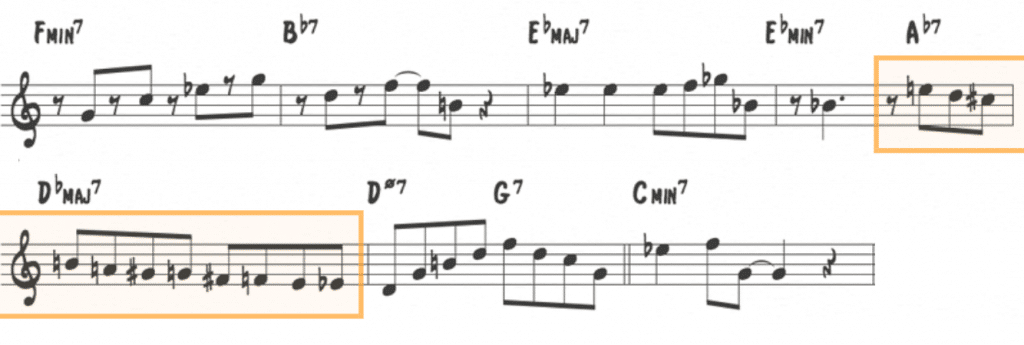It’s just past one in the morning. I’m standing on the sidewalk in lower Manhattan as garbage trucks rumble by and panhandlers hustle for loose change. I’ve just stepped outside of Smalls, the last note of the show still ringing in my ears…
After a few minutes, a well known trumpet player steps out and we start a conversation. I tell him I’ve been trying to learn Kenny Dorham’s approach to chords. That I’ve been searching for records and trying to understand his musical concept.
And I also concede that I haven’t been exactly successful in my pursuit. There’s just too much. He pauses and says, “You know, you could probably get all of K.D.’s language by checking out the album Showboat. It’s all on that record.”
And then it hit me…
You don’t have to spend years transcribing dozens of records from one great player to learn their language – you can focus on just one solo.
This is the secret every solo from a master holds. Every phrase contains the musical concepts they’ve developed, their harmonic “tricks,” and years of technical practice.
It’s all right there for the taking…
Time for a new approach
The truth is, you could spend a year transcribing every John Coltrane solo from 1958. You could write down every note from Hank Mobley’s entire recorded catalog. And you could painstakingly transcribe 20 Tommy Flanagan solos in a row…
But at the end of all that work you’re going to find the same musical concepts…over and over again.
Sure, there is great value in transcribing entire solos – we’ve written a ton about that here. But for musicians looking to quickly gain musical techniques and change the way they improvise, there is an easier way to locate and learn important musical concepts.
You see, transcribing as many solos you can or trying to absorb long complex lines every time you get into the practice room is not exactly efficient. If you’re smart about the process you can save time and effort, quickly isolating & ingraining important techniques.
Remember, the goal at the end of the day is to leave the practice room with specific techniques that you can use in your own solos.
Today we’ll show you how to extract important musical concepts from master musicians with just one solo or even a few musical phrases. To switch to the mindset of less in more.
Below, we’ll take 4 master musicians and extract one important technique from each, using a single solo. Let’s get started…
I. Clifford Brown: Enclosure
Nearly every serious improviser has studied, or at least closely listened, to the solos of Clifford Brown. Imitating his sound, his articulation, his flowing melodic lines…
However, if you transcribe twenty Clifford Brown solos and analyze the way he constructs his lines, you’ll notice one technique popping up over and over again… enclosure.
You don’t have to spend months transcribing dozens of solos to isolate and ingrain this important concept in your playing, you can simply take one phrase.
Check out Clifford’s solo over the jazz standard Confirmation:
At the opening of his solo [0:48], Clifford plays the line below:
If you look and listen closely, you’ll see that he is targeting important goal notes in the chord progression with enclosures:
This technique allows Clifford to create long melodic lines that emphasize the important notes of the chord progression. In this line he aims for the 3rd of the A7 and C minor chords the root of the Bb7 and G7 chords with enclosures.
Let’s find another line from this solo that utilizes this technique. At [1:42] he plays this line over the same chord sequence:
Again, he creates melodic motion by targeting important chord tones with enclosure. In this example the 5th of F Maj, the the root of D min:
In just 10 bars of music, you have enough material to study how Clifford utilizes enclosures in a melodic way. And you could continue through this solo line by line or analyze his solos on Joy Spring or Cherokee, and you’d find numerous examples of the exact same concept.
With a few short musical phrases you can isolate the specific melodic techniques that your favorite players use – techniques that you can then apply to your own solos.
Here’s what you should practice:
Rather than stealing one lick that you can use whenever you play Confirmation, isolate the underlying concept at work in Clifford’s lines.
By mastering melodic enclosure, you’ll be able to apply this technique to any tune that you play. Start by practicing enclosures on individual chords in every key, and then apply it to your lines over chord progressions.
Here are 4 examples…Enclosures applied to the chord tones of Major chords:
- Enclosures applied to the chord tones of Dominant (V7) chords:
- Enclosures applied to the chord tones of Minor 7 chords:
- And enclosing goal notes within a chord progression (ii-V-I):
Ingrain these techniques in every key and then use Clifford’s lines as a model for creating your own melodic lines over chords and progressions.
II. Roy Hargrove: Playing outside the harmony
Next, we’ll check out a musical from the trumpeter Roy Hargrove. Specifically, a technique that he uses to play outside of the established harmony in his solos.
Let’s take a listen to Hardgroove from the RH Factor album of the same name:
The harmonic backdrop of this tune consists of an A phyrigian vamp while the improvised lines largely center around A minor pentatonic material.
However, at [3:15] in Roy plays the following line that clashes with the A phyrigian sound:
Here, Hargrove uses two devices to move outside of the tonality. He begins a half-step above the key (Bb minor) and utilizes a whole-tone scale:
The Bb minor pentatonic material clashes with the underlying A tonality while the whole-tone scale creates melodic dissonance.
Utilizing a symmetrical scale like the whole-tone allows you to move freely outside the tonality because the structure of the line itself creates continuity – all without relying on consonance with an underlying chord.
You’ll probably noticed that he uses a chromatic cell (which are also symmetrical) to transition between the two devices. You can also use chromatic motion to create a line that defies the written tonality.
Let’s check out one more example of outside playing from this solo. At [3:41] Roy plays this line, again over the A phrygian vamp:
This time Roy moves outside of the harmony by playing half-step below the underlying chord. In this line he uses a G# minor pentatonic approach to the A phryigian sound:
Then he follows with some C# minor pentatonic material, ending on the 3rd of the chord.
Here’s what you should practice:
The easiest way to move outside of the harmony, regardless of the tune you’re playing or the chord you’re on, is to utilize material either a half-step above or below the root.
In both of the examples above, Roy begins his outside line a half-step away from the root (Bb- over A, G#- over A). Practice this harmonic approach over static chords.
If you have an extended vamp or section of the same chord, say for instance a C minor chord, practice using material a half-step above and below the root:
As Roy does in the first example, you should practice playing whole-tone scales or patterns over static chords, either starting on chord tones or non-diatonic notes. (Remember, there are only two variations of the whole-tone scale.)
Finally, work on using chromatic movement or cells to transition away from the existing harmony:
Starting in the home key, use chromatic motion to move seamlessly to outside material, for example moving from C minor to C# minor.
III. Brad Mehldau: Consonance and dissonance
The pianist Brad Mehldau is well known for his melodic dexterity and harmonic freedom. In this section, we’ll look at one technique that he uses to move seamlessly from consonant to dissonant material over standard progressions.
To do this, let’s take his solo on Solar from the album Art of the Trio Vol. 4:
At [4:20] in his solo he plays the following line:
Starting with standard consonant or diatonic material over a ii-V in Eb, Mehldau quickly transitions to dissonant material over the Db Maj chord:
Heading into the Db chord he begins using melodic material that is a half-step above the root, implying D major. Then he uses chromatic motion to resolve smoothly the root of the Dø7, continuing with consonant material in G7 and C-7.
Like Roy Hargrove did in his solo, Mehldau knows that the quickest way outside a tonality is a half-step away.
Let’s find another line from this solo that utilizes the same concept. In the next phrase, at [4:29], Mehldau again moves from diatonic lines over F major and to dissonant material over Eb Major:
Over the Eb Major chord he transitions to an E Major triad and resolves chromatically to the Db Major chord at the end of the phrase.
If you listen to the entire solo, you’ll be able to find many more examples of this technique, some more explicit than others.
Here’s what you should practice:
Assuming you’ve transcribed some musical language, you have melodic techniques for improvising over basic chords, and you understand the ii-V-I progression…
You can practice this technique by taking a common chord progression or tune that you are familiar with, a ii-V-I in C Major for instance:
Choose which part of the progression you want to use dissonant material or go outside of the harmony. It could be on the ii-V:
Or the C Major chord:
In the examples above, Meldau uses three tactics for moving from consonace to dissonance in his melodic lines:
- 3 note lead-in to dissonant material
- Plays outside with melodic material a half-step above the root
- Use of chromaticism to return to diatonic material
With the example we highlighted, work on creating lines over this ii-V progression that utilize these three tactics.
IV. Mulgrew Miller: Altering V7 chords
One important musical concept that you can learn from any great improvisers is how they approach dominant chords in their solos.
Specifically, what techniques they use to add interest and harmonic tension to this versatile chord. Let’s check out which techniques the master pianist Mulgrew Miller uses to alter the dominant chords in his solos.
Listen to his solo on If I Should Lose You:
Mulgrew begins his solo over an A7 chord with the following line:
On this dominant chord, he utilizes material from the altered scale and the b2 minor triad (Bb- over A7).
In the second measure he encloses the b13 (F) or A7 and descends down a Bb- triad including the C as a passing tone before resolving to the 5th of D minor.
Over V7 chords you can think of the b2 minor triad or the melodic minor, whichever is easier for you to access as you improvise. They come from the same harmonic approach and highlight the #9 and b9 to resolve to the 5th of the I chord.
Let’s check out another example of this technique from the same solo. A moment later Mulgrew uses this technique in the line below:
This time over a C7 chord, Mulgrew utilizes a descending minor triad from the b2 (Db-) that resolves to the 5th of the I chord:
In this line he alters the V7 chord of a ii-V-I progression, accessing the descending b2 triad from the b13 (#5) of C7.
And here’s one more example over another ii-V in F, however this time, he delays the resolution to the I chord:
Here Mulgrew uses the same technique over the C7 chord (Db-), but instead of resolving to F at the beginning of the measure, he delays the resolution for two beats:
Like the other two players above, you could analyze the rest of this solo and many of Mulgrew’s other solos and find the same b2 technique on dominant chords time after time.
Here’s what to practice:
As with all the musical concepts that we covered so far, there is a mental aspect that you need to ingrain and a technical aspect that you need to ingrain.
Start by visualizing the b2 minor triad over the dominant chord in every key:
Once you have that down, play it on your instrument. The goal is to be able to access this sound on the fly without thinking about it.
Then practice implementing this device over the dominant chords that you encounter in tunes and progressions, for example ii-V-I’s:
Use Mulgrew’s lines as a guide, incorporating enclosure, passing tones, and chromaticism with the b2 minor triad and delaying the resolution to the I chord.
Now it’s time to study your favorite players…
Every great player has developed specific melodic and harmonic concepts that they use in their approach to improvisation. Techniques for creating melodic lines, navigating chord progressions, and playing outside of the harmony…
And as an aspiring improviser, you should too.
In all of the examples above, you’ll find techniques for isolating these musical concepts from master musicians and ingraining them in your musical approach. Now, your job is to find these concepts in the players that you admire.
Remember, you don’t have to transcribe each and every recording to find these musical concepts, and you don’t have to spend weeks trying to translate them into your own playing.
With just a few phrases from a single solo, you have enough to extract their techniques, to learn them in all keys, and to implement them in your own solos.
Focus on the solos that you love and the musical phrases that catch your ear. With a good foundation in ear training and a little harmonic knowledge, you’ll be able to make significant progress each day in the practice room.








































